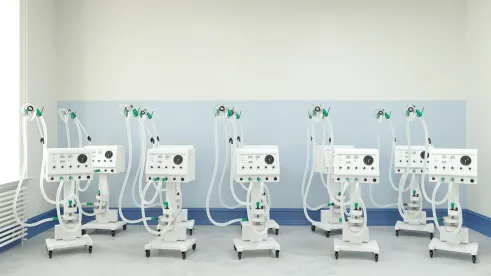On August 6, 2020, President Trump signed an Executive Order (EO) that directs certain federal agencies to prioritize purchasing certain essential medicines, medical countermeasures and critical inputs that are made in the United States. The EO applies to all federal agencies and departments involved in the procurement of such goods. After last week’s EO restricting the ability of government contractors to employ foreign nationals, this is the latest in a series of EOs promoting the administration’s Buy American, Hire American agenda. This agenda, which will be implemented through the federal procurement process, will likely have an outsized impact on companies doing business with the U.S. government and will likely adversely impact individuals who are covered beneficiaries under federally-funded health care programs.
The full scope of the EO, however, has yet to be determined. The EO directs the Food and Drug Administration (FDA) — in consultation with other agencies — to produce a list of “essential medicines, medical countermeasures and critical input” that will be covered by the new requirements within 90 days, or by November 6, 2020. Considering the already heavy workload the FDA is facing with the public health emergency, it is unclear how the EO may impact FDA’s response time on pending reviews and other matters.
No later than 30 days after the FDA has established the list of covered products, the United States Trade Representative will take action to modify relevant free trade agreements and the World Trade Organization Agreement on government procurement to exclude coverage of the identified goods. Further, no later than 60 days after the list has been published by the FDA, the Secretary of Defense shall be required under the Defense Federal Acquisition Regulation Supplement to restrict the procurement of such goods to qualifying made-in-USA products. However, the EO does not define domestic origin goods or the amount of foreign inputs that may be included in domestically produced products.
The EO provides certain exceptions to such mandatory sourcing requirements. Specifically, the EO establishes exceptions where: (1) the EO’s application would be inconsistent with the public health; (2) there is insufficient product being domestically produced; (3) application of the EO would lead to a 25% or more cost increase; or (4) the procurement is occurring in response to a designated public health or other national emergency. Agencies utilizing any of the first three exceptions will have to annually report on the justification for utilizing an exception.
A secondary purpose of the EO — that may ultimately have a broader impact on existing pharmaceutical manufacturers and supply chains — relates to the President’s direction to the Secretary of Health and Human Services (HHS) to identify vulnerabilities in the medical supply chain within 180 days. Specifically, the EO directs the Secretary of HHS to consider proposing regulations or revise existing guidance on information gathering with respect to the supply chain. The EO also seeks to streamline various regulatory requirements to expedite the development of additional pharmaceutical manufacturing in the United States. Notably, the regulatory approval process for qualifying a new drug manufacturing facility is time- and resource-intensive for both the company and FDA.
Even if certain regulatory approval requirements are minimized, companies will likely face challenges satisfying their contractual obligations, which may result in a host of contractual compliance issues. Companies have relied for decades on the stability of trade agreements in creating manufacturing processes and establishing viable supply chains that cannot be modified overnight. Efforts to do so will not only cause contractors to incur significant cost, some of which may even be reimbursable under their contracts, but will likely put the companies in a position where they are unable to fulfill requirements and adequately perform against their government contracts, let alone their contractual commitments to foreign governments and to commercial customers. It is also not clear what the EO means for the plethora of foreign pharmaceutical and life sciences companies providing essential products to the U.S. government.
The EO is a strong political statement from the White House on how it is prioritizing, from a national security and public health perspective, the return of pharmaceutical manufacturing to the United States. Commenting on the EO, White House trade adviser Peter Navarro emphasized this point further, warning that the United States is “dangerously over-dependent on foreign nations for our essential medicines, for medical supplies and medical equipment like ventilators.” Navarro explained that a key goal of the EO was to “establish a base level of demand to attract a level of investment sufficient to provide for the needs we have for these things we need in times of trouble.”
In this regard, the EO is consistent in sentiment, if not in all details, with a number of bills recently introduced by both Democrats and Republicans aimed at increasing domestic manufacturing and which have generally garnered bipartisan interest. Additionally, there is a predominant congressional attitude that the drug and pharmaceutical supply chain in particular needs attention. The issue, which started gaining some attention prior to the COVID-19 pandemic, has since picked up speed among both parties as the outbreak has spread. That said, implementation of this EO could easily result in drug shortages — an outcome that could be avoided (while still achieving the ultimate goal of increased domestic pharmaceutical production) if the U.S. government would instead invoke the Defense Production Act.
Further, President Trump’s announcement of the EO during a speech at an industrial plant in Ohio highlighted its place in the administration’s overall strategy on China. It was announced as part of a broad-ranging speech that detailed various aspects of the administration’s continuing efforts to reduce U.S. reliance on trade with China — efforts that have also accelerated as the COVID-19 pandemic continues to effect the United States.
It remains to be seen whether a Biden or second Trump administration will continue or expand upon the EO in 2021. However given the bipartisan congressional interest in this issue, we will likely continue to see the ultimate objectives of the EO pursued no matter the outcome of the election.
Nonetheless, since implementation of the EO will begin this year and likely be completed soon after the presidential inauguration in January 2021, it will be critical for companies in the health care and medical industries — and those companies that support them — to carefully evaluate the EO and its potential impact on their own businesses and supply chains, as well as continue to monitor the implementation of the EO and related supply chain legislation.








 />i
/>i

